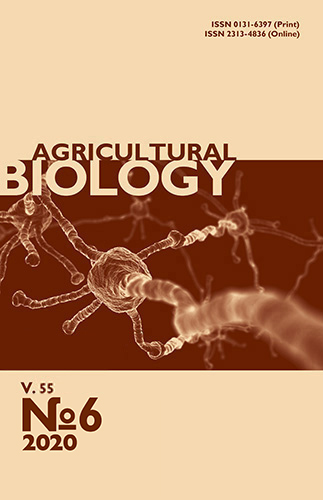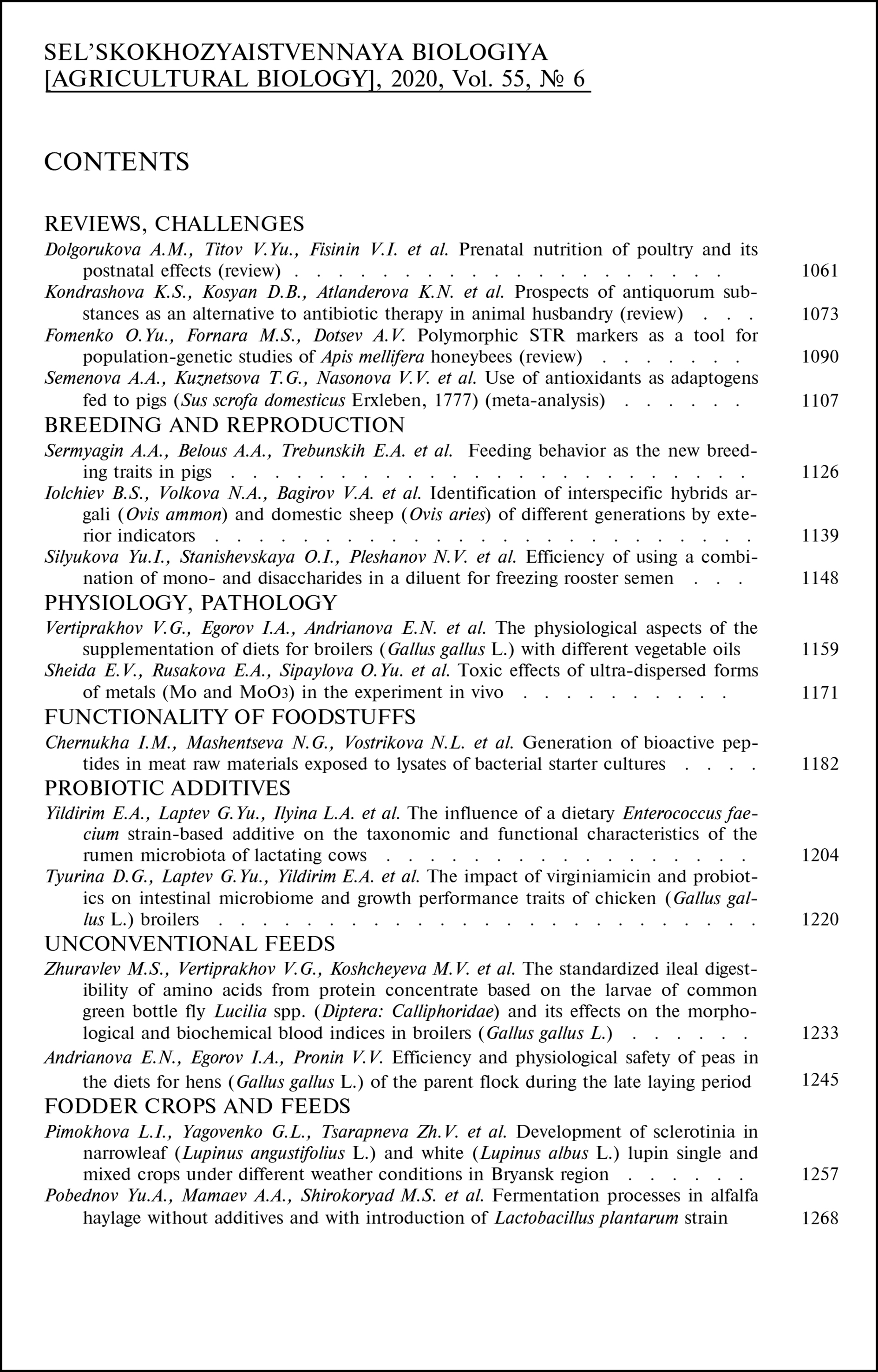doi: 10.15389/agrobiology.2020.6.1245eng
UDC: 636.5:636.086.2/.3
Acknowledgements:
The work was performed in accordance with the task No. R&D AAAA-A17-117062660105-5.
EFFICIENCY AND PHYSIOLOGICAL SAFETY OF PEAS IN THE DIETS FOR HENS (Gallus gallus L.) OF THE PARENT FLOCK DURING THE LATE LAYING PERIOD
E.N. Andrianova1 ✉, I.A. Egorov1, V.V. Pronin2
1Federal Scientific Center All-Russian Research and Technological Poultry Institute RAS, 10, ul. Ptitsegradskaya, Sergiev Posad, Moscow Province, 141311 Russia, e-mail andrianova@vnitip.ru (corresponding author ✉), olga@vnitip.ru, vnitip@vnitip.ru, alex.shevy@mail.ru;
2Federal Center for Animal Health Control, FGBU VNIIZZh, mkr. Yurievets, Vladimir, 600901 Russia, e-mail proninvv63@mail.ru
ORCID:
Andrianova E.N. orcid.org/0000-0002-6769-6351
Pronin V.V. orcid.org/0000-0002-6240-3062
Egorov I.A. orcid.org/0000-0001-9122-9553
Received July 13, 2020
Feeds are accounted for ca. 70 % of the commercial production costs of eggs and poultry meat. The use of other legumes (lupine, peas, horse beans, vetch) can lower the feed costs. However, the antinutritive factors of the legumes should be taken into account in the receipt formulation, especially in diets for pedigree flocks. Earlier we have proven physiological safety and effectiveness of the inclusion of 15 % of lupine in diets for layer parental flock. The substitution of peas for soybeans and lupine as the dietary protein source can further lower the costs of finisher diets for broilers and post-peak diets for layers where reduced protein levels are required. In the study presented we found efficient the substitution of peas (5 and 10 %) for soybean meal and sunflower cake in diets for parental flock of cage-housed layer chicken (cross SP 78, 30 birds per treatment) at the end of prolonged productive period (54-71 weeks of age). Control treatment 1 was fed the complete mash compound feed with soybeans as protein source; in diets for treatments 2, 3, and 4 the soybeans were increasingly substituted by peas (5, 10, and 15 % of total diet, respectively). After the artificial insemination 100 eggs from each treatment was taken since 70 weeks of age and incubated in DANKI incubator (Belgium) in constant regime. The temperature was set at 37.7 °С during 1-18 days of incubation and 37.2 °С during 18-21 days and controlled with the accuracy 0.1 °С; the relative humidity during these periods was 52-53 and 52-75 %, respectively. Mortality level, egg production, feed conversion ratios (per 10 eggs and per 1 kg of eggs laid), egg fertility and hatchability were recorded. The concentrations of vitamins and caroteniods in liver, chemical composition of liver, tibial concentrations of calcium and phosphorus were determined according to standard methods. The effects of the antinutritive factors were assessed via the histological study of the liver (at 71 weeks of age, n = 12); the samples were taken in 1 hour after the euthanasia from the similar liver part (lateral side of the right lobe) and fixed in 10 % neutral aqueous formalin. It was found that the inclusion of 5 and 10 % of peas into the diets of parental layer flock increased the intensity of lay by 2.38 and 4.97 % in compare to control, respectively, output of egg mass per hen housed by 3.78 and 12.23 %; the percentage of infertile eggs in these treatments was lower in compare to control. The histological study of liver revealed that 15 % of peas can launch the cytotoxic effect on the hepatic structures and induce the hepatic steatosis. This effect should be taken into account in the receipt formulations. It could be also concluded that peas can be included into the diets without preliminary thermal treatment; the antinutritive effects of pectin, trypsin inhibitors and proteases, tannins could be alleviated via the additional supplementation of the diets with exogenous enzymes, organic acids, and hepatoprotective agents.
Keywords: Pisum sativum L., peas, laying hens, egg production, hatch of chicks, hatchability of eggs, fertility of eggs, mortality, hepatic histology.
REFERENCES
- Andrianova E.N., Egorov I.A., Grigor'eva E.N., Shevyakov A.N., Pronin V.V. Lupine is applicable in diets for layer chicken of parental flock. Agricultural Biology [Sel'skokhozyaistvennaya biologiya], 2019, 54(2): 326-336 CrossRef
- Difo V.H, Patiene C.K, Elmugheira M.I.M. Under-utilized legumes as potential poultry feed ingredients: a mini- review. Archives of Animal & Poultry Sciences, 2018, 1(1): 555551.
- Kowalska E., Kucharska-Gaca J., Kuźniacka J., Lewko L., Gornowicz E., Biesek J., Adamski M. Quality of eggs, concentration of lysozyme in albumen, and fatty acids in yolk in relation to blue lupin-rich diet and production cycle. Animals (Basel), 2020, 10(4): 735 CrossRef
- Gueguen J., Cerletti P. Proteins of some legume seeds: soybean, pea, faba bean and lupin. In: New and developing sources of food. B.J.F. Hudson (ed.). Springer, Boston, MA, 1994: 145-193 CrossRef
- Okolelova T., Savchenko V, Prosviryakova O. Zhivotnovodstvo Rossii, 2009, 4: 51 (in Russ.).
- Zuber T., Siegert W., Salehi H., Hummel F., Rodehutscord M. Variability of amino acid digestibility of lupin and pea grains in caecectomised laying hens. Br. Poult. Sci., 2019, 60(3): 229-240 CrossRef
- Borisenko K.V., Vertiprakhov V.G. Zootekhniya, 2019, 2: 20-26 CrossRef (in Russ.).
- Castell A.G., Guenter W., Igbasan F.A. Nutritive value of peas for nonruminant diets. Animal Feed Science and Technology, 1996, 60: 209-227 CrossRef
- Okolelova T., Shchukina S. Using efficiency of acidifying agent Biotronic and enzymes in mixed feed with high pea content for broilers. World’s Poultry Science Journal,2006, 62: 395.
- Egorov I.A., Manukyan V.A., Okolelova T.M., Lenkova T.N., Andrianova E.N., Shevyakov A.N., Egorova T.V., Egorova T.A., Baikovskaya E.Yu., Gogina N.N., Krivoruchko L.I., Sysoeva I.G., Men'shenin I.A., Grigor'eva E.N., Panin I.G., Grechishnikov V.V., Panin A.I., Kustova S.V., Afanas'ev V.A., Ponomarenko Yu.A. Rukovodstvo po kormleniyu sel'skokhozyaistvennoi ptitsy. Pod redaktsiei V.I. Fisinina, I.A. Egorova [Dietary requirements of poultry: Guidelines for feeding. V.I. Fisinin, I.A. Egorov (eds.)]. Sergiev Posad, 2018 (in Russ.).
- Rubio L.A., Pérez A., Ruiz R., Guzmán M.Á., Aranda-Olmedo I., Clemente A. Characterization of pea (Pisum sativum) seed protein fractions. J. Sci. Food Agric., 2014, 94(2): 280-287 CrossRef
- Witten S., Grashorn M.A., Aulrich K. Precaecal digestibility of crude protein and amino acid of field bean (Vicia faba L.) and field pea (Pisum sativum L.) variety for broilers. Animal Feed Science and Technology, 2018, 243: 35-40 CrossRef
- Grosjean F., Barrier-Guillot B., Bastianelli D., Rudeaux F., Bourdillon A., Pegronnet C.Feeding value of three categories of pea (Pisum sativum L.) for poultry. Animal Science, 1999, 69: 591-599 CrossRef
- Lemme A., Ravindran V., Bryden W.L. Ileal digestibility of amino acids in feed ingredients for broilers. World’s Poultry Science Journal, 2004, 60: 423-437 CrossRef
- Longstaff M., Mcnab J.M. The inhibitory effects of hull polysaccharides and tannins of field beans (Vicia faba L.) on the digestion of amino acids, starch and lipid and digestive enzyme activities in young chicks. British Journal of Nutrition, 1991, 65: 199-216 CrossRef
- Igbasan F.A., Guenter W. The influence of micronization, dehulling and enzyme supplementation on the nutritional value of peas for laying hens. Poultry Science, 1997, 76: 331-337 CrossRef
- Okolelova T. Kombikorma, 2003, 5: 46-47 (in Russ.).
- Koivunen E., Talvio E., Valkonen E., Tupasela T., Tuunainen P., Valaja J. Use semi-leafless peas (Pisum sativum L.) with enzyme addition in diets for broilers. Agricultural and Food Science, 2016, 25: 90-98 CrossRef
- Bevzyuk V. Ptitsevodstvo, 2004, 1: 18-19 (in Russ.).
- Mustafin A., Imangulov Sh. Ptitsevodstvo, 2005, 5: 26 (in Russ.).
- Ciurescu G., Pan C.O. Effect of dietary untreated field pea (Pisum sativum L.) as substitute for soybean meal and enzymes supplementation on egg production and quality of laying hens. Romanian Biotechnological Letters, 2017, 22(1): 12204-12213.
- Kuźniacka J., Biesek J., Banaszak M., Grabowicz M., Adamski M. The quality of eggs from Rosa 1 hens fed diets containing seeds of legume plants (Lupinus luteus L., Lupinus angustifolius, and Pisum sativum) in two laying phases. Animals (Basel), 2020, 10(11): 1942 CrossRef
- Konopleva A.P., Trokholis T. V sbornike: Trudy VNITIP [Proceedings of the VNITIP]. Sergiev Posad, 2012, v. 86: 24-35 (in Russ.).
- Avtandilov G.G., Yabluchanskii N.I., Gubenko V.G. Sistemnaya stereometriya v izuchenii patologicheskogo protsessa [Systemic stereometry in the study of the pathological process]. Moscow, 1981 (in Russ.).
- Tashke K. Vvedenie v kolichestvennuyu tsito-gistologicheskuyu morfologiyu [Introduction to quantitative cyto-histological morphology]. Budapesht, 1980 (in Russ.">CrossRef
- Lakin G.F. Biometriya [Biometrics]. Moscow, 1990 (in Russ.).
- Chmielnicka A., Żabka A., Winnicki K., Polit J.T. Plant storage proteins — the main nourishing products — from biosynthesis to cellular storage depots. Postepy Hig. Med. Dosw. [Advances in Hygiene and Experimental Medicine], 2017, 71(0): 530-540 CrossRef
- Bingol N.T., Dede S.I., Karsli M.A., Değer Y., Kiliçalp Kılınç D., Çetin S. Effects of the replacement of soybean meal with pea as dietary protein source on the serum protein fractions of broilers. Brazilian Journal of Poultry Science, 2016, 18(4): 639-644 CrossRef
- Zafar M.H., Fatima M. Efficiency comparison of organic and inorganic minerals in poultry nutrition: a review. PSM Vet. Res., 2018, 3(2): 53-59.
- Leterme P., Monmart T., Baudart, E. Amino acid composition of pea (Pisum sativum) proteins and protein profile of pea flour. J. Sci. Food Agric., 1990, 53: 107-110 CrossRef
- Fru-Nji F., Niess E., Pfeffer E. Effect of graded replacement of soybean meal by faba beans (Vicia faba L.) or field peas (Pisum sativum L.) in rations for laying hens on egg production and quality. The Journal of Poultry Science, 2007, 44: 34-41 CrossRef
- Röhe I., Goodarzi Boroojeni F., Zentek J. Effect of feeding soybean meal and differently processed peas on intestinal morphology and functional glucose transport in the small intestine of broilers. Poultry Science, 2017, 96(11): 4075-4084 CrossRef
- Riasi A., Mahdavi A.H., Bayat E. Effect of different levels of raw and heated grass pea seed (Lathyrus sativus) on nutrient digestibility, intestinal villus morphology and growth performance of broiler chicks. J. Anim. Physiol. Anim. Nutr. (Berl.), 2015, 99(5): 924-931 CrossRef
- Rao G., Shrivastava S. Toxic and antinutritional factors of new varieties of pea seeds. Research Journal of Pharmaceutical, Biological and Chemical Sciences, 2011, 2: 512-523.
- Witten S., Böhm H., Aulrich K. Effect of variety and environment on the contents of crude nutrients, lysine, methionine and cysteine in organically produced field peas (Pisum sativum L.) and field beans (Vicia faba L.). Landbauforschung — Appl. Agric. Forestry Res., 2015, 65(3/4): 205-216 CrossRef
- Hejdysz M., Kaczmarek S.A., Rutkowski A. Effect of extrusion on the nutritional value of peas for broiler chickens. Arch. Anim. Nutr., 2016, 70(5): 364-377 CrossRef












